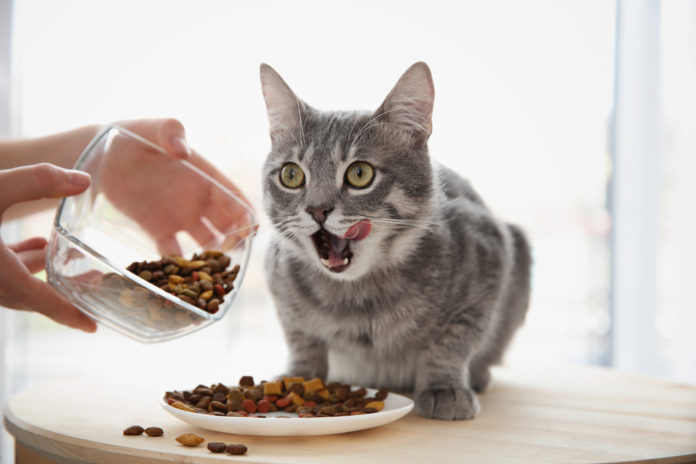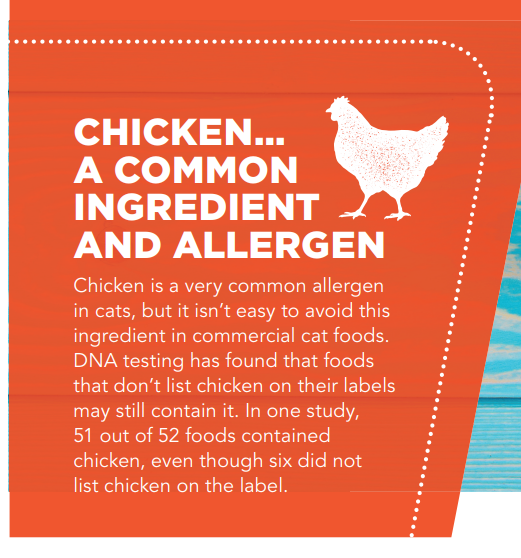Does your cat have a food allergy — or a food intolerance?

They’re not one and the same. Understanding the difference between a food allergy and food intolerance is the first step to helping your cat back to health.
If your cat has a problem with a particular food, you probably assume he’s allergic to it. But that’s not necessarily the case. True food allergies are relatively uncommon. In fact, your cat may actually have what’s termed a food intolerance. Let’s take a look at food allergies and intolerances in cats, and the differences between their causes, symptoms, and treatments.
Food intolerance
Also called food sensitivity, food intolerance is a common problem. It’s an adverse reaction to some component of the food, such as additives. Symptoms are usually confined to the digestive tract, with stomach pain, vomiting, or diarrhea being the most common. However, skin rash and itching may also occur.
Adult cats are typically lactose intolerant, so foods containing whey, cheese, or other dairy products may be the culprit for many felines. Food additives such as dyes, BHA, guar gum, and histamines are often implicated. Even certain spices and added antioxidants may be a problem. Fish such as tuna and mackerel used in canned cat food may be quite high in histamine, and may cause vomiting, diarrhea, itchiness, and skin flushing in some cats.
What’s the solution?
Fortunately, the solution to a food intolerance is simple: change the diet.
- Keep in mind that within a brand, similar ingredients tend to be used across the board, so just changing flavors may not be enough. Switching to a different brand, however, may bring relief.
- Using a different form of the same diet may also work. There have been cases in which cats reacted to a dry food but not to the same brand and flavor of canned food, and vice versa.
- If a cat reacts to cooked meat, try raw; alternatively, if he has an adverse reaction to raw meat, try cooking it.
If your cat has a simple food intolerance, his symptoms will start to resolve within days, and be gone in a week or two. If he is still having problems, talk to your veterinarian about putting him on an elimination diet to help uncover the aggravating ingredients (see sidebar).
 Food allergy
Food allergy
Food allergies are much more complex than food intolerances, and involve the immune system. Allergies tend to develop to one or more proteins that the cat has been exposed to for months or years. You might ask: “But my cat’s been eating that food for ten years, so how can she suddenly be allergic to it?” It’s actually very typical for an allergy to develop after years of exposure to the food in question. In fact, food allergies are very rare in cats under six months of age, but any adult cat may develop one.
Immune cells can react to any protein, including food proteins. When these cells sense a foreign invader, antibodies will be produced to destroy it. When the trigger is a normally harmless food protein, this constitutes a food allergy.
Technically, the gastrointestinal tract is outside the body. It’s a long tube that opens to the outside at either end. But within the body, the cells lining the gut form a barrier so there is no direct access from inside the tube to the rest of the body. Food gets broken down, taken up by those lining cells, and routed either to the blood or the lymph. This process works perfectly, unless there is some type of injury or inflammation that breaks down the barrier function.
 Certain foods are known to cause inflammation in the intestines. Gluten, sugar, nightshades (such as potatoes, tomatoes, and peppers), nuts, and vegetable oils can be quite irritating. Once inflamed, the tight junctions between intestinal barrier cells become loose or “leaky.” At that point, food and other particles that have not been fully digested can squeeze through.
Certain foods are known to cause inflammation in the intestines. Gluten, sugar, nightshades (such as potatoes, tomatoes, and peppers), nuts, and vegetable oils can be quite irritating. Once inflamed, the tight junctions between intestinal barrier cells become loose or “leaky.” At that point, food and other particles that have not been fully digested can squeeze through.
But the immune system is ready for just such an invasion. Right behind those lining cells are lots and lots of immune cells. Whatever food proteins get through will be treated as invaders and taken through the antibody production process. Food proteins that have been denatured (distorted) by cooking or high heat processing may also be seen as foreign and get the antibody treatment. Thereafter, any time those antibodies come across those proteins, they’ll stick to them and cause a destructive inflammatory reaction wherever they may find them.
In cats, food allergies are most likely to cause inflammation in the skin, particularly around the face and ears. Many, if not most, feline ear infections are caused by food allergies. Gastrointestinal signs may also occur, and can include vomiting, diarrhea, and constipation.
Both food allergy and food intolerance can cause similar symptoms, although intolerance more often causes GI signs, while allergies more commonly manifest in the skin, where they can cause terrible itching and rash-like eruptions.
What’s the solution?
In humans, it has long been thought that avoiding potential allergens is the best plan. However, recent research suggests that early exposure to small amounts of allergens may be a better strategy.
To that end, it may be wise to expose cats to a variety of proteins and food forms when they’re young, and to periodically rotate the diet – e.g. different brands, protein sources, and type of processing (raw, cooked, canned, dry) — to prevent the long-term exposure that seems to be such a problem. In other words, variety may be the key to fewer food allergies throughout a cat’s lifetime.
If your cat already seems to have a food allergy, an elimination diet designed by your veterinarian can again help pinpoint the trigger/s.
As mentioned earlier, food allergies in cats are relatively rare, while food intolerances are quite common. Knowing the difference between the two conditions, and how they manifest, can help you (with your vet’s help) get to the bottom of the problem more quickly.



